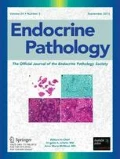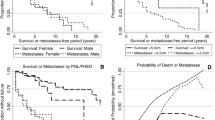Abstract
Paragangliomas of the urinary bladder can arise sporadically or as a part of hereditary syndromes including those with underlying mutations in the succinate dehydrogenase (SDH) genes, which serve as tumor suppressors. SDH deficiency can be screened for by absence of immunohistochemical detection of SDHB. In this study of 11 cases, clinical follow-up was available for 9/11 cases. The cases were reviewed and graded based on the grading system for adrenal pheochromocytomas and paragangliomas (GAPP) criteria. Immunohistochemistry was performed for Ki67 and SDHB. Proliferative index was calculated by quantification of Ki67-positive cells at hot spots. The medical record was accessed for documentation of germline SDH mutations. Urinary bladder paragangliomas had a female predilection (8/11 cases), and 5/11 cases exhibited metastatic behavior. Patients with metastatic disease tended to be younger (mean age 43 vs 49 years), have larger lesions (5.8 vs 1.5 cm), and presented with catecholamine excess (4/4 vs 2/6 patients with non-metastatic lesions). Patients with metastatic disease had a higher mean Ki67 proliferation rate (4.9 vs 1.3 %) and GAPP score (mean of 5.8 vs 3.8) (p = 0.01). IHC for SDHB expression revealed loss of expression in 2/6 cases of non-metastatic paragangliomas compared to 4/5 patients with metastatic paragangliomas. Interestingly, of these four patients, two had a documented mutation of SDHB, one patient had a SDHC mutation, and another patient had a history of familial disease without mutation analysis being performed. Our study, suggests that SDH loss was suggestive of metastatic behavior in addition to younger age at diagnosis, larger tumor size, and higher Ki67 proliferation rate and catecholamine type.




Similar content being viewed by others
References
Fletcher, T.F. and W.E. Bradley, Neuroanatomy of the bladder-urethra. The Journal of urology, 1978. 119(2): p. 153-60.
Rode, J., A. Bentley, and C. Parkinson, Paraganglial cells of urinary bladder and prostate: potential diagnostic problem. Journal of clinical pathology, 1990. 43(1): p. 13-6.
Dixon, J.S., et al., An immunohistochemical study of human postnatal paraganglia associated with the urinary bladder. Journal of anatomy, 1992. 181 (Pt 3): p. 431-6.
Thrasher, J.B., et al., Pheochromocytoma of urinary bladder: contemporary methods of diagnosis and treatment options. Urology, 1993. 41(5): p. 435-9.
Dahm, P. and J.E. Gschwend, Malignant non-urothelial neoplasms of the urinary bladder: a review. European urology, 2003. 44(6): p. 672-81.
Zhou, M., J.I. Epstein, and R.H. Young, Paraganglioma of the urinary bladder: a lesion that may be misdiagnosed as urothelial carcinoma in transurethral resection specimens. The American journal of surgical pathology, 2004. 28(1): p. 94-100.
Cheng, L., et al., Paraganglioma of the urinary bladder: can biologic potential be predicted? Cancer, 2000. 88(4): p. 844-52.
Mason, E.F., et al., Identification of succinate dehydrogenase-deficient bladder paragangliomas. The American journal of surgical pathology, 2013. 37(10): p. 1612-8.
Giubellino, A., et al., Urinary Bladder Paragangliomas: How Immunohistochemistry Can Assist to Identify Patients With SDHB Germline and Somatic Mutations. The American journal of surgical pathology, 2015. 39(11): p. 1488-92.
Martucci, V.L., et al., Association of urinary bladder paragangliomas with germline mutations in the SDHB and VHL genes. Urologic oncology, 2015. 33(4): p. 167 e13-20.
Zimmerman, I.J., R.E. Biron, and H.E. Macmahon, Pheochromocytoma of the urinary bladder. The New England journal of medicine, 1953. 249(1): p. 25-6.
Ricketts, C.J., et al., Succinate dehydrogenase kidney cancer: an aggressive example of the Warburg effect in cancer. The Journal of urology, 2012. 188(6): p. 2063-71.
Vander Heiden, M.G., L.C. Cantley, and C.B. Thompson, Understanding the Warburg effect: the metabolic requirements of cell proliferation. Science, 2009. 324(5930): p. 1029-33.
Neumann, H.P., et al., Distinct clinical features of paraganglioma syndromes associated with SDHB and SDHD gene mutations. JAMA, 2004. 292(8): p. 943-51.
Amar, L., et al., Genetic testing in pheochromocytoma or functional paraganglioma. Journal of clinical oncology : official journal of the American Society of Clinical Oncology, 2005. 23(34): p. 8812-8.
Lodish, M.B., et al., Succinate dehydrogenase gene mutations are strongly associated with paraganglioma of the organ of Zuckerkandl. Endocrine-related cancer, 2010. 17(3): p. 581-8.
Welander, J., P. Soderkvist, and O. Gimm, Genetics and clinical characteristics of hereditary pheochromocytomas and paragangliomas. Endocrine-related cancer, 2011. 18(6): p. R253-76.
Gimenez-Roqueplo, A.P., P.L. Dahia, and M. Robledo, An update on the genetics of paraganglioma, pheochromocytoma, and associated hereditary syndromes. Hormone and metabolic research = Hormon- und Stoffwechselforschung = Hormones et metabolisme, 2012. 44(5): p. 328-33.
Gill, A.J., et al., Immunohistochemistry for SDHB triages genetic testing of SDHB, SDHC, and SDHD in paraganglioma-pheochromocytoma syndromes. Human pathology, 2010. 41(6): p. 805-14.
Papathomas, T.G., et al., SDHB/SDHA immunohistochemistry in pheochromocytomas and paragangliomas: a multicenter interobserver variation analysis using virtual microscopy: a Multinational Study of the European Network for the Study of Adrenal Tumors (ENS@T). Modern pathology : an official journal of the United States and Canadian Academy of Pathology, Inc, 2015. 28(6): p. 807-21.
van Nederveen, F.H., et al., An immunohistochemical procedure to detect patients with paraganglioma and phaeochromocytoma with germline SDHB, SDHC, or SDHD gene mutations: a retrospective and prospective analysis. The Lancet. Oncology, 2009. 10(8): p. 764-71.
Pasini, B., et al., Clinical and molecular genetics of patients with the Carney-Stratakis syndrome and germline mutations of the genes coding for the succinate dehydrogenase subunits SDHB, SDHC, and SDHD. European journal of human genetics : EJHG, 2008. 16(1): p. 79-88.
Stratakis, C.A. and J.A. Carney, The triad of paragangliomas, gastric stromal tumours and pulmonary chondromas (Carney triad), and the dyad of paragangliomas and gastric stromal sarcomas (Carney-Stratakis syndrome): molecular genetics and clinical implications. Journal of internal medicine, 2009. 266(1): p. 43-52.
Gaal, J., et al., SDHB immunohistochemistry: a useful tool in the diagnosis of Carney-Stratakis and Carney triad gastrointestinal stromal tumors. Modern pathology : an official journal of the United States and Canadian Academy of Pathology, Inc, 2011. 24(1): p. 147-51.
Williamson, S.R., et al., Succinate dehydrogenase-deficient renal cell carcinoma: detailed characterization of 11 tumors defining a unique subtype of renal cell carcinoma. Modern pathology : an official journal of the United States and Canadian Academy of Pathology, Inc, 2015. 28(1): p. 80-94.
Kimura, N., et al., Pathological grading for predicting metastasis in phaeochromocytoma and paraganglioma. Endocrine-related cancer, 2014. 21(3): p. 405-14.
Benn, D.E., et al., Novel succinate dehydrogenase subunit B (SDHB) mutations in familial phaeochromocytomas and paragangliomas, but an absence of somatic SDHB mutations in sporadic phaeochromocytomas. Oncogene, 2003. 22(9): p. 1358-64.
Eisenhofer, G. and A.S. Tischler, Neuroendocrine cancer. Closing the GAPP on predicting metastases. Nature reviews. Endocrinology, 2014. 10(6): p. 315-6.
Eisenhofer, G., et al., Plasma methoxytyramine: a novel biomarker of metastatic pheochromocytoma and paraganglioma in relation to established risk factors of tumour size, location and SDHB mutation status. European journal of cancer, 2012. 48(11): p. 1739-49.
Gupta, S., et al., High grade neuroendocrine carcinoma of the urinary bladder treated by radical cystectomy: a series of small cell, mixed neuroendocrine and large cell neuroendocrine carcinoma. Pathology, 2015. 47(6): p. 533-42.
Timmers, H.J., et al., Clinical aspects of SDHx-related pheochromocytoma and paraganglioma. Endocrine-related cancer, 2009. 16(2): p. 391-400.
Mannelli, M., et al., Clinically guided genetic screening in a large cohort of italian patients with pheochromocytomas and/or functional or nonfunctional paragangliomas. The Journal of clinical endocrinology and metabolism, 2009. 94(5): p. 1541-7.
Brouwers, F.M., et al., High frequency of SDHB germline mutations in patients with malignant catecholamine-producing paragangliomas: implications for genetic testing. The Journal of clinical endocrinology and metabolism, 2006. 91(11): p. 4505-9.
Author information
Authors and Affiliations
Corresponding author
Rights and permissions
About this article
Cite this article
Gupta, S., Zhang, J., Rivera, M. et al. Urinary Bladder Paragangliomas: Analysis of Succinate Dehydrogenase and Outcome. Endocr Pathol 27, 243–252 (2016). https://doi.org/10.1007/s12022-016-9439-2
Published:
Issue Date:
DOI: https://doi.org/10.1007/s12022-016-9439-2




